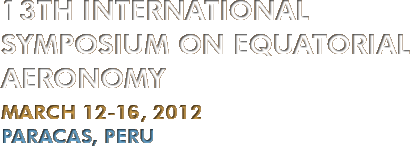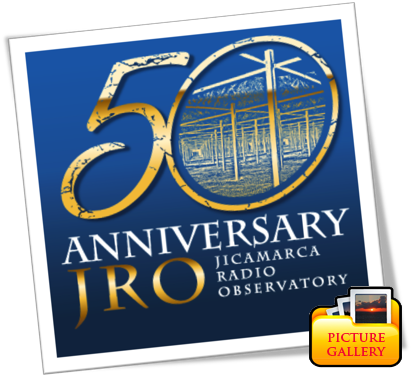
| Sessions | Topics |
S1: Irregularity Physics |
In the past few years, equatorial aeronomers have made significant progress toward understanding the evolution of ionospheric plasma structures and irregularities encompassing scales ranging from meters to hundreds of kilometers. Through observations, simulations, and theory researchers are making steady progress toward understanding and modeling F-region equatorial plasma bubbles, mid-latitude E- and F- region irregularities, meteor trail physics, and the old problem of the non-linear behavior of the Farley-Buneman and Gradient-Drift instabilities. New studies of 150-km echoes have given us a number of clues which should help scientists understand the origin of this enigmatic radar phenomenon. This session welcomes the submission of papers addressing recent experimental, computational and theoretical studies of E- and F- region plasma irregularities. This includes the formation, evolution, and nonlinear properties of km- to m- scales. Research addressing the day-to-day variability of spread F irregularities, including those detected by C/NOFS instruments, are appropriate for this session. |
S2: E and F region coupling (low and mid latitude coupling) |
Understanding the coupling between the E and F region at low and midlatitudes is important to elucidate the physics behind several processes occurring there. This coupling involves electromagnetic forcingeffects between the regions connected by the geomagnetic field. In addition to local coupling, effects from the conjugate hemisphere seem to play an important role in the overall behavior of the processes observed. This session solicits contributions related to coupling studies between the E and F region. Contributions focusing on multi-instrument observations, computer simulation and theoretical studies, ionospheric irregularities, wave phenomena, and effects of neutral atmosphere processes are encouraged. |
S3: Wave propagation between low/middle atmosphere and ionosphere |
This session will focus on the main atmospheric waves such as acoustic-gravity waves, solar tides, planetary waves, Kelvin waves, etc. that primarily originate in the lower atmosphere, and on their transmission into the upper atmosphere. The session will address both theoretical and empirical recent results concerning the transfer of momentum and energy by internal atmospheric waves, breaking and dissipation in the MLT region, wave-wave and wave-mean flow interaction, chemical and dynamical coupling processes, and the MLT response to equatorial oscillations such as QBO and SAO. Contributions are particularly sought that focus on MLT wave seeding (wave penetration and secondary wave generation) of ionospheric disturbances and longitudinal structures and the dependence of wave coupling processes on the solar and geomagnetic activity. As it is widely recognized that numerical simulations driven by integrated ground-based and satellite observations are a powerful tool for quantitatively understanding the complex atmosphere-ionosphere system, and that they are a vital means for predicting the wave coupling processes, such results are most welcome. The main objective of this session is to provide the next opportunity for the international research community to review the progress made so far and suggest some future directions, particularly in studying the role of waves in atmosphere-ionosphere coupling. |
| S4: Plasma neutral coupling Convener: P. Roddy Co-Conveners: R. Heelis E. Nossa |
A systems approach to research requires the identification of the key components of the system and of the pathway through which those components couple. In the upper atmosphere, treating the neutral and ionized fluids as components of the system is attractive, since paradigms are well established for understanding each one separately. However, distinctly new, emergent phenomena occur when the two components act together, and understanding these requires close examination of the coupling and the ways it contributes to feedback and complexity. The coupling can be local in space, as in the case of sporadic ionization layers driven by sheared neutral flows or of neutral atmospheric heating and forcing by neutral and plasma instabilities driven by local sources of free energy. Important also are processes initiated nonlocally, by waves propagating upward from the lower atmosphere or by coupled E and F region and plasmaspheric electrodynamics, for example. Important coupling takes place not only across spatial boundaries (altitudinal, latitudinal) but also across spatial and temporal scales. This session seeks contributions that will help elucidate the most important communication pathways between the neutral and ionized components of the system and the phenomena they create. |
| S5: Low and mid latitude Aeronomy and Electrodynamics Convener: J. Meriwether Co-Conveners: S. González E. Pacheco |
The main emphasis of session S5 is to focus on the behavior of electric fields and current systems on a global large scale during quiet times. The aim would be to provide a broad overview of how the ionosphere behaves during geomagnetic quiet times and weak solar activity and during the transition to a more intense solar activity period. Emphasis would be placed upon the description of the plasma component in regard to composition, density, temperature, and the background climatology of the neutral winds and ion drifts. Papers devoted to phenomenological features such as the equatorial ionization anomaly, pre-reversal enhancement, midnight temperature maximum/pressure bulge, and the electrodynamics at the terminators during quiet times and their relationships to the wind systems and tides would be welcomed. Specific topics may be: 1. Studies of the electrodynamics of the ionosphere: description of recent results in composition, density, temperature, electric fields, ion drifts, transport, gravitational and magnetic field effects, mainly during quiet times or during the transition from quiet to storm time. 2. Ground-based in-situ measurements and related modeling 3. Climatological studies (latitudinal, longitudinal, altitudinal, seasonal variation, solar conditions) and particular events relating to gravity wave perturbations and tidal variability. |
| S6: Ionospheric storms and Space weather effects at low and mid latitudes. Convener: H. Takahashi Co-Conveners: D. Pallamraju N. Maruyama |
Response of the equatorial-, low-, and mid-latitude ionosphere to geomagnetic storms is extremely complex and calls for focused attention addressing the consequences of various space weather effects. During geomagnetic storms, time varying magnetosphere-ionosphere-thermosphere interactions at high latitudes cause a host of disturbances, such as, large scale traveling atmospheric/ionospheric disturbances, under/overshielding and disturbance dynamo electric fields, and dramatic variations in the total electron content. All these show global scale signatures, and do have a great influence on ionosphere/thermosphere at mid-, low-, and equatorial latitudes, which could also result in the generation of plasma irregularities. Human activities today depend so much on the high technology applications in the near earth space, such as satellite operations, aviations, radio wave communications, and Global Navigation Satellite System (GNSS) positioning, and the accuracies in these measurements are adversely affected by the gradients in electron contents and plasma irregularities. Thus, experimental, theoretical, and modeling efforts are all extremely essential for improving our understanding of the ionospheric/thermospheric disturbances at all latitudes during geomagnetic storms and substorms. Recent progress in space-based (TIMED, CHAMP, COSMIC, C/NOFS), and ground-based (Radars, GNSS receivers, optical sensors, magnetometer chains) observations has allowed us to diagnose space weather effects in geospace. Furthermore, advancement in theory and modeling efforts help us elucidate the underlying physics in the observations. Specific topics to be discussed in this session are: (1) Storm time variations in ionospheric plasma and electrodynamics, (2) Prompt penetration and disturbance dynamo contributions in the storm time electric field, (3) Ionospheric scintillations due to space weather during both quiet and disturbed conditions, at low and mid-latitudes. This session, therefore, welcomes presentations of all aspects of the response of the equatorial-, low-, and mid-latitude ionosphere to the space weather effects. Keywords: - Experiment, theory, modeling efforts |
| S7: New techniques, experiments, campaigns, and results Convener: R. Pfaff Co-Conveners: C. Valladares S. Raizada |
In this session, we solicit papers describing new experimental techniques, experiments, and campaigns, that are, or will be, used to investigate the ionosphere and atmosphere at low latitudes. Examples of new techniques include daytime Fabry-Perot Interferometers (FPI), new radar modes and configurations, and new types of in situ probes, for example to measure neutral winds on satellites and sounding rockets. We also ask for papers describing new radiowave techniques, such as those that use tomography, GPS, satellite occultations, and beacons, to explore the low latitude ionosphere and upper atmosphere. Ideas for establishing a new heater facility at an equatorial or low latitude site along with optical instruments (daytime FPI, lidars, imagers) are also requested. Presentations are encouraged that show results from new multi-technique clusters and observatory chains that have recently emerged and that promise to reveal new insights regarding atmosphere-ionosphere coupling with both global and regional (i.e., continental) coverage. For example, papers with new results from magnetometer baselines, ionosonde chains, and GPS networks operating at low latitudes are solicited as well as presentations on new satellite or rocket missions, continuous conjugate observations using incoherent scatter radars (AMISR), imagers, and/or networks of instruments. The session will include results from dedicated observing campaigns, such as those exploring the dynamics of the ionosphere in order to investigate the onset conditions for different types of plasma irregularities and structures which thus shed light on the causes of the day-to-day variability of the ionosphere. Comparative studies between continuous measurements or campaigns conducted at different equatorial regions of the globe (e.g., South America, Africa, India, and the West Pacific) are particularly encouraged. Finally, we request theoretical and modeling presentations that describe how to best use measurements from the new instrumentation and campaigns to further our understanding of the low latitude ionosphere-thermosphere coupling and the generation of plasma structures. |
| S8: Future trends and challenges Convener: M. Larsen Co-Conveners: M. Hagan C. La Hoz |
- Altitude and latitude coupling as drivers for equatorial dynamics (stratospheric warming effects, migrating vs. non-migrating tides, F region/E region coupling effects in the equatorial region and for midlatitude irregularities) - Extracting new information from existing techniques (e.g., radar imaging, meteor trail tracking, dynamical parameters from network measurements) - Integrating large datasets (multiple instrument datasets, model output/dataset integration) - Next-generation numerical models of the coupled geospace system. - Meeting the operational needs for space weather prediction. |


|
» 2012/09/06
» 2012/08/20
» 2012/03/30
|







